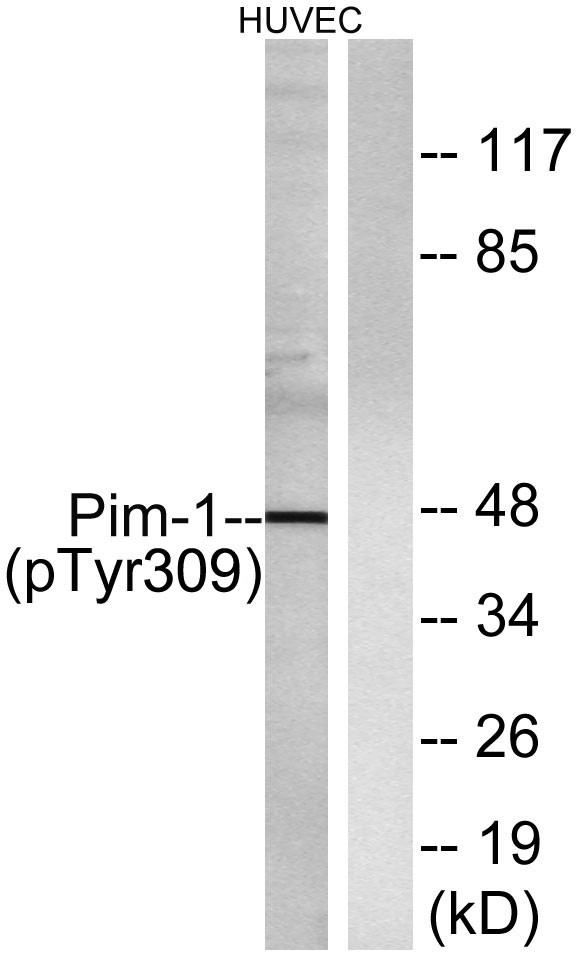Pim-1 (phospho Tyr309) Polyclonal Antibody
- Catalog No.:YP0331
- Applications:WB;ELISA
- Reactivity:Human;Mouse;Rat
- Target:
- Pim-1
- Fields:
- >>JAK-STAT signaling pathway;>>AGE-RAGE signaling pathway in diabetic complications;>>Pathways in cancer;>>MicroRNAs in cancer;>>Acute myeloid leukemia
- Gene Name:
- PIM1
- Protein Name:
- Serine/threonine-protein kinase pim-1
- Human Gene Id:
- 5292
- Human Swiss Prot No:
- P11309
- Mouse Swiss Prot No:
- P06803
- Rat Gene Id:
- 24649
- Rat Swiss Prot No:
- P26794
- Immunogen:
- The antiserum was produced against synthesized peptide derived from human Pim-1 around the phosphorylation site of Tyr309. AA range:281-330
- Specificity:
- Phospho-Pim-1 (Y309) Polyclonal Antibody detects endogenous levels of Pim-1 protein only when phosphorylated at Y309.
- Formulation:
- Liquid in PBS containing 50% glycerol, 0.5% BSA and 0.02% sodium azide.
- Source:
- Polyclonal, Rabbit,IgG
- Dilution:
- WB 1:500 - 1:2000. ELISA: 1:40000. Not yet tested in other applications.
- Purification:
- The antibody was affinity-purified from rabbit antiserum by affinity-chromatography using epitope-specific immunogen.
- Concentration:
- 1 mg/ml
- Storage Stability:
- -15°C to -25°C/1 year(Do not lower than -25°C)
- Other Name:
- PIM1;Serine/threonine-protein kinase pim-1
- Observed Band(KD):
- 45kD
- Background:
- The protein encoded by this gene belongs to the Ser/Thr protein kinase family, and PIM subfamily. This gene is expressed primarily in B-lymphoid and myeloid cell lines, and is overexpressed in hematopoietic malignancies and in prostate cancer. It plays a role in signal transduction in blood cells, contributing to both cell proliferation and survival, and thus provides a selective advantage in tumorigenesis. Both the human and orthologous mouse genes have been reported to encode two isoforms (with preferential cellular localization) resulting from the use of alternative in-frame translation initiation codons, the upstream non-AUG (CUG) and downstream AUG codons (PMIDs:16186805, 1825810).[provided by RefSeq, Aug 2011],
- Function:
- catalytic activity:ATP + a protein = ADP + a phosphoprotein.,cofactor:Manganese.,function:Plays a role in signal transduction in blood cells. Contributes to both cell proliferation and survival and thus provide a selective advantage in tumorigenesis. May affect the structure or silencing of chromatin by phosphorylating HP1 gamma/CBX3.,induction:Strongly induced in leukocytes by the JAK/STAT pathway in response to cytokines.,PTM:Autophosphorylated on both serine/threonine and tyrosine residues.,similarity:Belongs to the protein kinase superfamily. CAMK Ser/Thr protein kinase family. PIM subfamily.,similarity:Contains 1 protein kinase domain.,subunit:Binds to RP9. Isoform 2 is isolated as a monomer whereas isoform 1 complexes with other proteins. Isoform 1, but not isoform 2, binds BMX.,tissue specificity:Expressed primarily in cells of the hematopoietic and germline lineages. Isoform 1 an
- Subcellular Location:
- [Isoform 1]: Cytoplasm. Nucleus.; [Isoform 2]: Cell membrane.
- Expression:
- Expressed primarily in cells of the hematopoietic and germline lineages. Isoform 1 and isoform 2 are both expressed in prostate cancer cell lines.
Elucidating direct kinase targets of compound Danshen dropping pills employing archived data and prediction models. Scientific Reports Sci Rep-Uk. 2021 May;11(1):1-13 WB Human 1:2000 MCF7 cell,T47D cell,TPC1 cell,BCPAP cell
- June 19-2018
- WESTERN IMMUNOBLOTTING PROTOCOL
- June 19-2018
- IMMUNOHISTOCHEMISTRY-PARAFFIN PROTOCOL
- June 19-2018
- IMMUNOFLUORESCENCE PROTOCOL
- September 08-2020
- FLOW-CYTOMEYRT-PROTOCOL
- May 20-2022
- Cell-Based ELISA│解您多样本WB检测之困扰
- July 13-2018
- CELL-BASED-ELISA-PROTOCOL-FOR-ACETYL-PROTEIN
- July 13-2018
- CELL-BASED-ELISA-PROTOCOL-FOR-PHOSPHO-PROTEIN
- July 13-2018
- Antibody-FAQs
- Products Images
.jpg)
- Wang, T., Liang, L., Zhao, C. et al. Elucidating direct kinase targets of compound Danshen dropping pills employing archived data and prediction models. Sci Rep 11, 9541 (2021).

- Western blot analysis of lysates from HUVEC cells treated with PMA 125ng/ml 30', using Pim-1 (Phospho-Tyr309) Antibody. The lane on the right is blocked with the phospho peptide.

